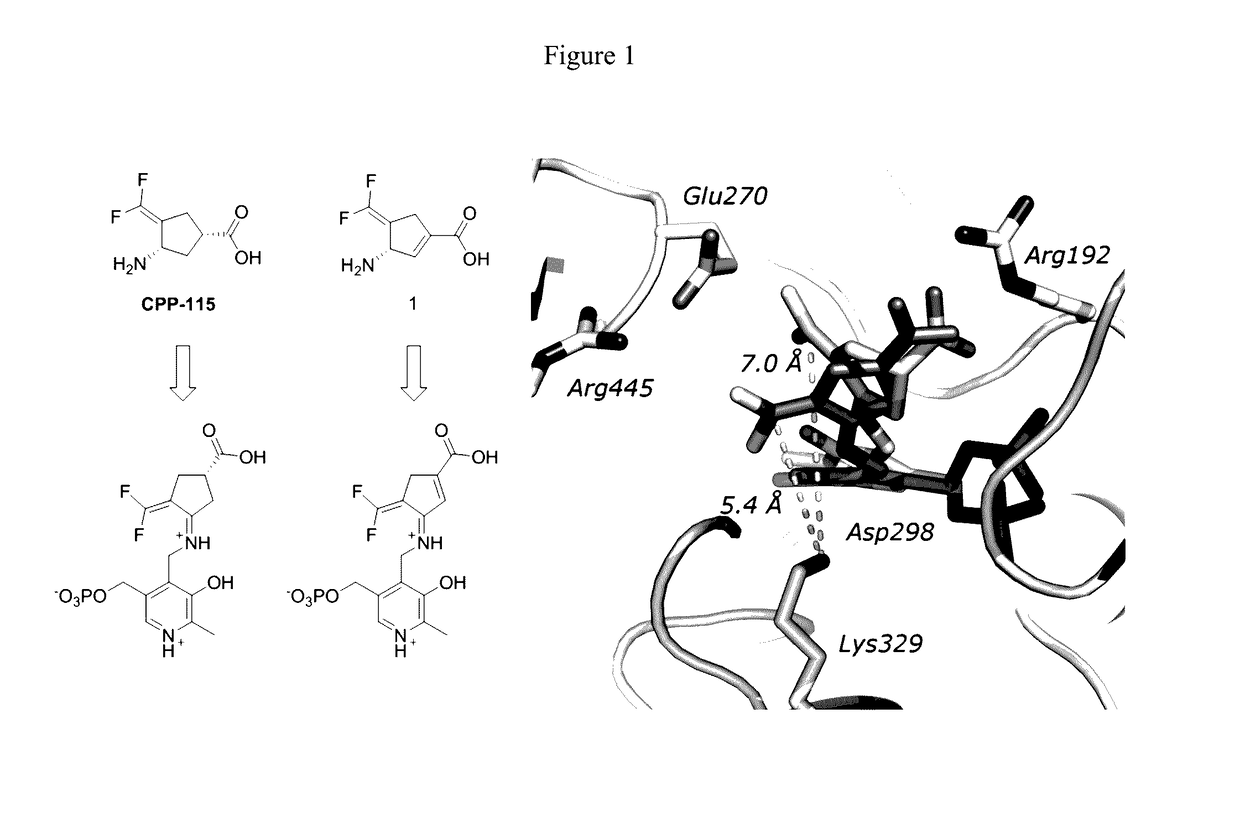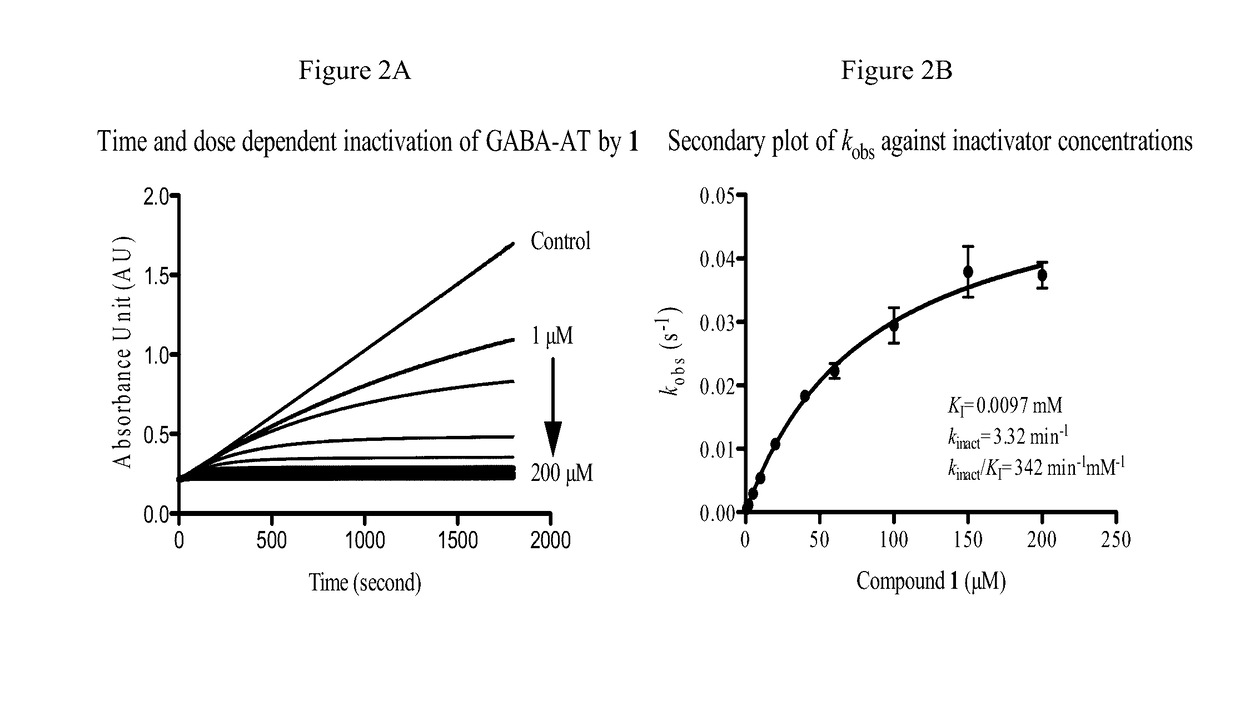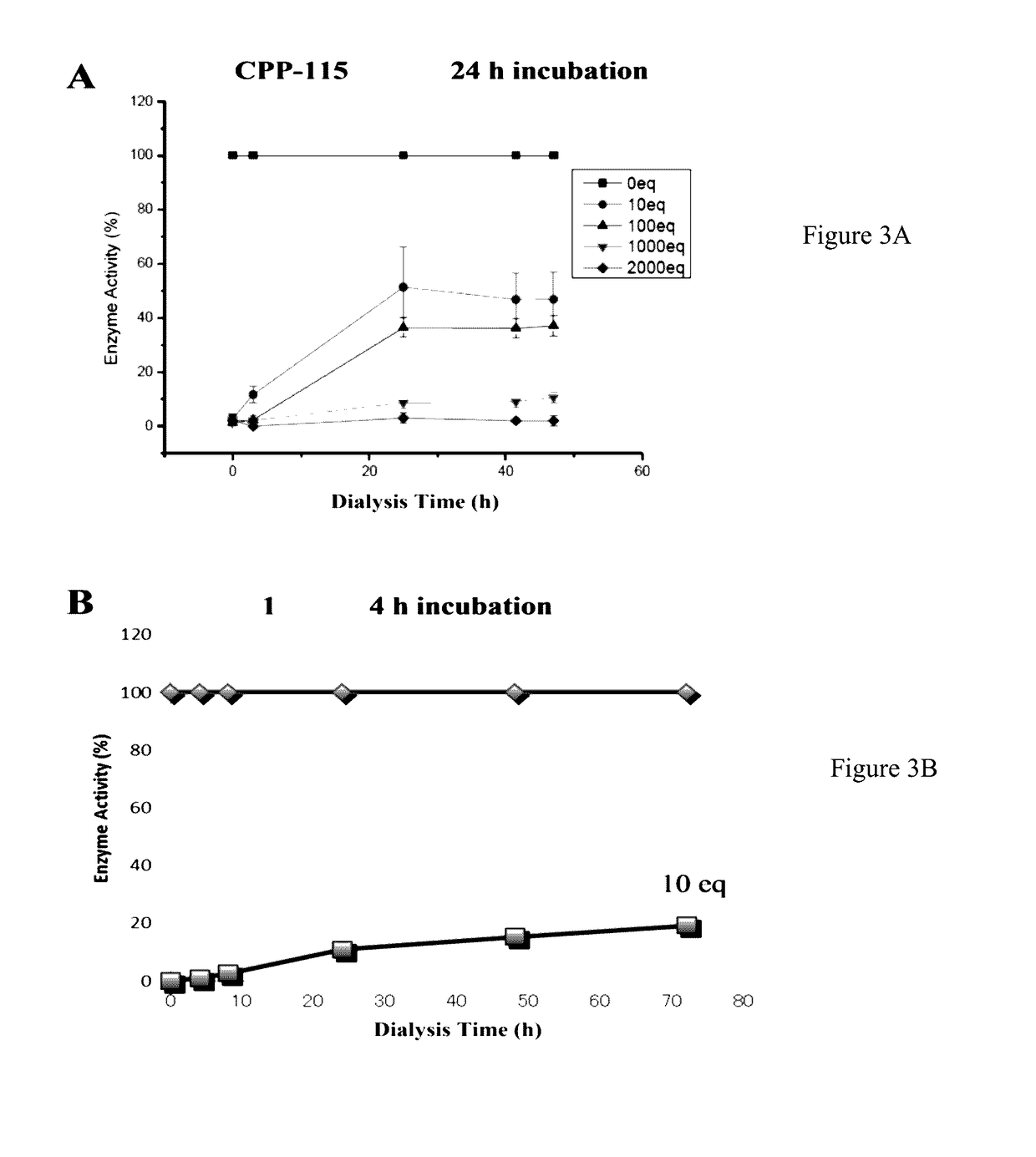(S)-3-amino-4-(difluoromethylenyl)cyclopent-1-ene-1-carboxylic acid, and related compounds as GABA aminotransferase inactivators for the treatment of epilepsy, addiction and hepatocellular carcinoma
a technology of difluoromethylenyl and cyclopent, which is applied in the field of(s)3amino4(difluoromethylenyl) cyclopent1ene1carboxylic acid, can solve the problems of too far for nucleophilic attack and the potential of vigabatrin for general therapeutic us
- Summary
- Abstract
- Description
- Claims
- Application Information
AI Technical Summary
Benefits of technology
Problems solved by technology
Method used
Image
Examples
example 1
[0070]Methyl (1S,3S)-3-((tert-butoxycarbonyl)amino)-4-(difluoromethylenyl)cyclopentane-1-carboxylate (3). To dry methanol (27 mL) was added acetyl chloride (2.49 mL, 35 mmol) at 0° C. and stirred for 10 min. To the resulting solution was added CPP-115 hydrochloride salt (1, 1.5 g, 7.0 mmol) and stirred for 24 h at room temperature. Triethylamine (6.8 mL, 49 mmol) and di-tert-butyl dicarbonate (1.9 mL, 8.4 mmol) were then added, and the resulting solution was stirred for 20 h at room temperature. The reaction mixture was concentrated and redissolved in ethyl acetate. The organic solution was washed with 2 N HCl, saturated NaHCO3, and brine. The organic layer was dried over Na2SO4, followed by filtration and evaporation to afford 3 (1.99 g, 6.83 mmol, 97%) as a white solid; 1H NMR (500 MHz, 60° C., DMSO-d6) δ 6.89 (s, 1H), 4.57 (s, 1H), 3.63 (s, 3H), 2.86 (m, 1H), 2.55-2.51 (m, 1H), 2.23 (ddt, J=10.0, 7.1, 2.9 Hz, 1H), 1.79 (m, 1H), 1.39 (s, 9H); 13C NMR (126 MHz, 60° C., DMSO-d6) δ 1...
example 2
[0071]Methyl (3S)-3-((tert-butoxycarbonyl)amino)-4-(difluoromethylenyl)-1-(phenylselanyl)cyclopentane-1-carboxylate (4). To a solution of KHMDS (14.96 mL of 1M solution in THF, 14.96 mmol) and dry THF (10 mL) at −78° C. was added a solution of 3 (1.98 g, 6.80 mmol) in dry THF (10 mL) slowly via syringe. The reaction mixture was stirred at −78° C. for 90 min. A solution of phenylselenyl chloride (1.43 g, 7.48 mmol) in dry THF (2 mL) was added and stirring was continued at −78° C. for 75 min. The reaction mixture was then allowed to warm to 0° C., stirred at 0° C. for 3 h, warmed to room temperature, and stirred at room temperature for 2 h. Saturated aqueous ammonium chloride and ethyl acetate were added. The organic layer was washed with saturated aqueous ammonium chloride and dried over Na2SO4. Filtration and evaporation gave a crude mixture, which was purified by silica gel column chromatography (hexane / EtOAc) to afford a 5:2 diastereomeric mixture (4, 2.12 g, 4.75 mmol, 70%) as a ...
example 3
[0072](3S)-3-((tert-Butoxycarbonyl)amino)-4-(difluoromethylenyl)-1-(phenylselanyl)cyclopentane-1-carboxylic acid (5). To a solution of 4 (1.40 g, 3.13 mmol) in methanol (14 mL) and water (4 mL) at 0° C. was added lithium hydroxide (225 mg, 9.39 mmol). The reaction mixture was allowed to warm to room temperature and was stirred for 20 h. Ethyl acetate was added and the organic solution was washed with 10% citric acid and brine. The organic layer was then dried over Na2SO4, filtered, and concentrated. The crude mixture was subjected to silica gel column chromatography (hexane / ethyl acetate) to afford 5 (1.25 g, 2.89 mmol, 92%) as a white powder. 1H NMR (500 MHz, 60° C., DMSO-d6) δ 12.61 (s, 1H), 7.64-7.54 (m, 2H), 7.46-7.42 (m, 1H), 7.41-7.35 (m, 2H), 6.94 (s, 1H), 4.81 (s, 0.7H), 4.48 (s, 0.3H), 2.97-2.83 (m, 1H), 2.67-2.56 (m, 0.7H), 2.35 (dd, J=16.9, 2.7 Hz, 0.7H), 2.20-2.10 (m, 1.3H), 1.91 (dd, J=12.9, 8.3 Hz, 0.3H), 1.42-1.35 (m, 9H); 13C NMR (126 MHz, DMSO-d6) δ 173.76, 173.56, ...
PUM
| Property | Measurement | Unit |
|---|---|---|
| temperature | aaaaa | aaaaa |
| temperature | aaaaa | aaaaa |
| path length | aaaaa | aaaaa |
Abstract
Description
Claims
Application Information
 Login to View More
Login to View More - R&D
- Intellectual Property
- Life Sciences
- Materials
- Tech Scout
- Unparalleled Data Quality
- Higher Quality Content
- 60% Fewer Hallucinations
Browse by: Latest US Patents, China's latest patents, Technical Efficacy Thesaurus, Application Domain, Technology Topic, Popular Technical Reports.
© 2025 PatSnap. All rights reserved.Legal|Privacy policy|Modern Slavery Act Transparency Statement|Sitemap|About US| Contact US: help@patsnap.com



